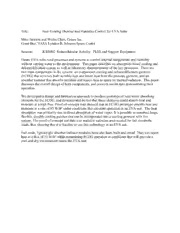
NASA Technical Reports Server (NTRS) 20100039613: Non-Venting Thermal and Humidity Control for EVA Suits PDF
Preview NASA Technical Reports Server (NTRS) 20100039613: Non-Venting Thermal and Humidity Control for EVA Suits
Title: Non-Venting Thermal and Humidity Control for EVA Suits Mike Izenson and Weibo Chen, Creare Inc. Grant Bue, NASA Lyndon B. Johnson Space Center Session: ICES402 Extravehicular Activity: PLSS and Support Equipment Future EVA suits need processes and systems to control internal temperature and humidity without venting water to the environment. This paper describes an absorption-based cooling and dehumidification system as well as laboratory demonstrations of the key processes. There are two main components in the system: an evaporation cooling and dehumidification garment (ECDG) that removes both sensible heat and latent heat from the pressure garment, and an absorber radiator that absorbs moisture and rejects heat to space by thermal radiation. This paper discusses the overall design of both components, and presents recent data demonstrating their operation. We developed a design and fabrication approach to produce prototypical heat/water absorbing elements for the ECDG, and demonstrated by test that these elements could absorb heat and moisture at a high flux. Proof-of-concept tests showed that an ECDG prototype absorbs heat and moisture at a rate of 85 W/ft² under conditions that simulate operation in an EVA suit. The heat absorption was primarily due to direct absorption of water vapor. It is possible to construct large, flexible, durable cooling patches that can be incorporated into a cooling garment with this system. The proof-of-concept test data was scaled to calculate area needed for full metabolic loads, thus showing that it is feasible to use this technology in an EVA suit. Full-scale, lightweight absorber/radiator modules have also been built and tested. They can reject heat at a flux of 33 W/ft² while maintaining ECDG operation at conditions that will provide a cool and dry environment inside the EVA suit.
